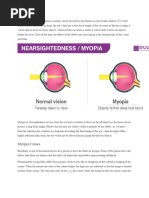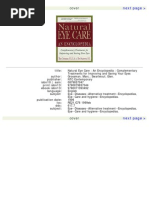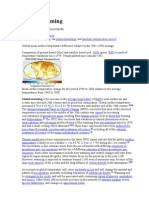Vision Report
Uploaded by
filiz8888Vision Report
Uploaded by
filiz8888Simple
Steps to Naturally Better Vision!
Imagine what your life would be
like if you’ve lost your eyesight. It is
quite likely that not only won’t you
be able to picture such a scenario,
but you will become terrified with
the sole thought of it.
Surprisingly, many surveys found
that the fear of blindness is the
strongest of all health related fears a person might have. For instance, recent study
illustrated that twice as many people are afraid of loosing their eyesight as are afraid of
death or cardiovascular problems.*
Although people are so fearful of loosing nature’s most precious gift – vision, only some do
something to protect, preserve or improve their eyesight. Moreover, the majority of the
people with vision disorders settle with the thought that they have poor vision and there is
nothing they can do to reverse that.
Many factors contribute to such a passive behavior – insufficient knowledge about vision,
lack of understanding of the causes and risk factors of the most common eyesight disorders,
underestimating the importance of certain lifestyle habits, including dietary habits and food
preferences, misjudgment of the most popular vision facts and fiction, insufficient physical
and eye exercising, these all influence eye health and visual acuity.
Regardless of the precise reason why a person fails to take proper care of their eyes, the
reality is that many vision problems are reversible and this is the exact reason why I’ve
decided to compile this guide. It will cover some of the most important topics about eye
health and eyesight improvement.
What you will find on the following pages:
• Improving Eyesight: Facts vs. Fiction
• How Eyes Work
(c) Copyright 2011 – http://naturallyimproveeyesight.com/main/ 1
Simple Steps to Naturally Better Vision!
• Eyesight Boosting Diet Secrets
• Great Eye Exercises for Improving Vision
• The Importance of Nutrition and Exercise Together
I trust the following advice will answer many of your questions, will increase your awareness
about vision and will help you take better care of your eyes and improve your vision
naturally!
Kristy White
Improving Eyesight: Facts vs. Fiction
While hereditary and environmental factors may lead to the
deterioration of your eye's health and cause eyesight problems so do
unhealthy habits, poor diet and lack of medical checkups. Clearly, a
person cannot be aware of everything that is good (or bad) for their
eyesight but knowing the main myths and facts about vision is
imperative.
Let’s take a quick look at some of the most widespread vision facts and fiction.
Fiction: Absolutely every eyesight disorder can be cured with eye exercises and relaxation.
Fact: Eye exercises and eye relaxation are very important for general eye health. Some vision
work-‐outs are aimed at preventing (or slowing down the progression) of some eyesight
disorders, while others are specifically targeted at natural vision correction. Many eyesight
disorders can be helped and even completely cured just by practicing eye exercises and
relaxation; many people not only restore their 20/20 visual acuity but gain better vision than
that.
(c) Copyright 2011 – http://naturallyimproveeyesight.com/main/ 2
Simple Steps to Naturally Better Vision!
However, certain eye diseases cannot be influenced by eye exercises. Generally, these are
eye diseases (glaucoma, age related macular degeneration, etc.) that involve permanent cell
and tissue damage or cell and tissue death.
Fiction: Crossing your eyes will make them stay that way.
Fact: The myth that if you cross your eyes, they will remain crossed forever is probably
devised by parents looking for a scary story that will make their kids forget about this habit.
In fact, if you cross your eyes they will not stay that way. Moreover, some eye workouts and
relaxation techniques actually ask people to cross their eyes in order to train their eye
muscles and thus to improve vision naturally. However, if you notice that your kid is crossing
their eyes often, you need to seek medical attention, as crossed-‐eyes are a sign of poor
vision in children.
Fiction: If your parents have poor vision, you will have poor vision too.
Fact: Unfortunately, this is not really a myth but reality. All refractive errors (myopia,
hyperopia and astigmatism) are hereditary. Some eye diseases that lead to severe vision
impairment and blindness are also genetic – glaucoma, macular degeneration, cataracts.
The good news is that there are many things you can do to delay the onset and even to
completely prevent some of the most common eyesight disorders. For example,
nearsightedness is hereditary but scientists have found that some environmental and
lifestyle factors are among the top risk factors of the condition and lead to its onset even in
people without family history of myopia. I strongly recommend you to read the chapter
Causes of Poor Vision: Facts and Fiction (p. 10) of my book Improve Your Vision Naturally
(you can get it at http://naturallyimproveeyesight.com/main/) where I give further details of
the top risk factors and causes of poor eyesight and eye health problems. Additionally, you
can self-‐test your vision with our useful tools, just check out the chapters dedicated to
glaucoma and macular degeneration.
(c) Copyright 2011 – http://naturallyimproveeyesight.com/main/ 3
Simple Steps to Naturally Better Vision!
Fiction: Wearing glasses will damage your vision further.
Fact: The myth that wearing prescription eyeglasses is bad for your eyes, and especially
detrimental if you are trying to improve your vision naturally, is totally wrong. Moreover,
eyeglasses are not impeding natural eyesight improvement, but helping it. What is important
is always to wear the correct eyeglasses prescription.
If you are eager to learn why wearing glasses is important for your eye health and eyesight
and how you can increase the benefits of wearing glasses, check out How to Increase the
Benefits of Wearing Glasses in a Natural Way, a special chapter in my book (p. 16) Improve
Your Vision Naturally.
Fiction: Computer use is harmful for eye health and vision acuity.
Fact: According to AAO, computer use cannot directly damage your eyes. But frequent and
extended staring at a computer screen poses other threats for your eyes. For instance, long
hours of close eye work are among the risk factors of nearsightedness.
If your work involves long hours of computer use, I strongly recommend you to read my
article How to Save Your Eyesight at the Computer (p. 140, Improve Your Vision Naturally).
In the same chapter you will find more helpful tips on how to preserve your vision at the
work place, including several beneficial eye exercises that prevent and relieve the symptoms
of computer vision syndrome.
How Eyes Work?
Before we move on to concrete methods for natural eyesight correction, it is important that
you understand how your eyes work. Do not worry – you do not need to gain thorough
knowledge about eye anatomy or eye physiology. What you need to do is to learn which the
main structures of the eye are and how are they responsible for good vision.
(c) Copyright 2011 – http://naturallyimproveeyesight.com/main/ 4
Simple Steps to Naturally Better Vision!
First, take a good look at the picture
on the left. It represents a simplified
schematic diagram of the structure
of the human eye.
The human eye consists of three
basic layers:
• Cornea (the outermost
transparent layer) and sclera
(the white of the eye).
• Choroids, ciliary body and iris
(the middle layer).
• Retina (the innermost layer).
The crystalline lens and a clear fluid called vitreous humour are situated inside these layers.
All of the above mentioned structures are involved in the actual process of seeing: the light
enters the eye through the cornea, passes through the pupil and through the lens and
focuses on the retina; from there it is sent, through the optic nerve, to the vision center of
the brain. You can learn more about the structure of the eye and the way it functions from
chapter "How Your Eyes Work?" (p. 14, Improve Your Vision Naturally).
As you can see, the actual process of “seeing” involves nearly all eye structures and thus
their integrity determines visual acuity. In other words, anatomical and/or physiological
disorders even in just one eye structure may lead to poor vision.
Refractive
errors
(nearsightedness,
farsightedness
and
astigmatism)
may
be
caused
by
irregularities
in
one
or
more
of
the
eye
structures
-‐
irregularly
shaped
cornea
(too
steep
or
too
flat),
irregularly
shaped
crystalline
lens
of
the
eye,
if
the
eye
is
too
long
or
too
short.
Poor
vision
may
be
caused
by
physiological
disorders
affecting
the
crystalline
lens
of
the
eye
or
the
retina.
(c) Copyright 2011 – http://naturallyimproveeyesight.com/main/ 5
Simple Steps to Naturally Better Vision!
Although poor vision may be caused by anatomical disorders, a growing body of research
suggests that some anatomical irregularities actually occur later in life and are caused by
specific lifestyle habits. For example, some scientists believe that increased vision stress and
close-‐up eye work may cause nearsightedness and/or astigmatism. Certain dietary and
lifestyle habits also lead to eye health problems and disruption of normal eye function.
Eyesight Boosting Diet Secrets
Surely, you are aware that the food you eat can influence your eye health and may be
directly responsible for the onset (or prevention) of many eyesight problems. Now, let’s
discuss the role of nutrition in specific eyesight problems – how to prevent, preserve and
improve eyesight naturally through a healthier diet. I will focus on nearsightedness, aging
vision (presbyopia), cataracts and macular degeneration and how you can help these
conditions through nutrition.
Nearsightedness (myopia)
Nearsightedness (myopia) is one of the most prevalent
Natural Dietary Sources and
refractive errors. It may be caused by hereditary or Daily Value (%)
acquired irregularities of some of the eye structures. Zinc, Selenium, Chromium
Clearly,
eye
anatomy
cannot
be
changed
with
diet
Zinc Serving DV
Calf’s liver 4 oz 72,0
alone;
however
a
healthy
vision
diet
can
slow
down
Beef 4 oz 42,2
Lamb 4 oz 30,7
further
pathological
changes
of
the
eye
and
thus
slow
Selenium Serving DV
down
the
progression
of
myopia.
Calf liver 4 oz 82,6
Tuna, Cod 4 oz 75,8
Scientists
believe
that
certain
vitamin
and
mineral
Shrimp 4 oz 64,2
deficiencies
increase
the
susceptibility
of
the
eye
to
Chromium Serving DV
Onions 1 cup 20,7
changes
caused
by
prolonged
close
eye
work.
Myopic
Lettuce 2 cups 13,1
people
need
to
have
a
diet
particularly
rich
in
foods
Tomato 1 cup 7,5
that
are
good
dietary
sources
of
selenium,
chromium
and
zinc.
Of
course,
all
other
vision
macro-‐
and
micro-‐nutrients
(Vitamin
A,
C,
D
and
E,
omega-‐3
fatty
acids)
must
also
present
in
adequate
quantities
in
their
nutrition
plan.
Aging Vision (Presbyopia)
(c) Copyright 2011 – http://naturallyimproveeyesight.com/main/ 6
Simple Steps to Naturally Better Vision!
Presbyopia, commonly called aging vision, is an age-‐related eyesight disorder. Unlike other
refractive errors and eye diseases, it is caused by the natural aging processes taking place in
the eye cells and tissues. Obviously, there is nothing you can do to completely forestall
aging. But you can significantly slow it down and thus postpone vision loss due to
presbyopia.
Natural Dietary Sources and
Daily Value (DV%)
A study reported that increasing the amount of lutein Vitamin E, Lutein &
in the diet resulted in an improvement in visual Zeaxanthin
acuity
(Olmedilla
et
al.
2003),
while
another
study
Vitamin E Serving DV
Sunflower seeds ¼ cup 90,5
suggested
that
lutein
supplementation
might
slow
(raw)
Almonds, roasted ¼ cup 44,9
aging
of
the
lens
(Berendschot
et
al.
2002).
Another
Olives 1 cup 20,1
study
suggested
that
Vitamin
E,
which
has
very
Lutein & Serving mg
beneficial
effect
in
people
with
cataracts,
helped
Zeaxanthin
Kale 1 cup 23,8
those
with
presbyopia
improve
their
near
vision.
Spinach 1 cup 20,4
Collards 1 cup 14,6
So,
a
good
presbyopia
diet
should
include
foods
rich
in
vitamin
E
and
lutein
(an
essential
nutrient
primarily
found
in
leafy
green
vegetables).
You
should
include
foods
rich
in
vitamin
C
and
vitamin
A
to
your
diet
too
because
these
vitamins
are
antioxidants.
Cataract & Macular Degeneration
Both cataract and macular degeneration are age-‐
Natural Dietary Sources and
related eye diseases. Cataract affects the crystalline Daily Value (%)
Zinc, Selenium, Chromium
lens of the eye and macular degeneration – the retina
of the eye. Cataract can be treated with eye surgery but Vitamin C Serving DV
Bell peppers 1 cup 291,3
little can be done for those with macular degeneration. Broccoli 1 cup 205,7
Strawberries 1 cup 136,1
Fortunately,
a
proper
diet
and
some
healthy
habits
can
Vitamin A Serving DV
Carrots 1 cup 686,3
greatly
delay
the
onset
of
cataract
and
macular
Calf’s liver 4 oz 609,7
degeneration
and
may
significantly
slow
down
their
Spinach 1 cup 377,3
progression.
Studies
reported
that
higher
dietary
intake
of
lutein
and
zeaxanthin
and
vitamin
E
can
significantly
decrease
the
risk
of
cataract
formation.
The
Age-‐Related
Eye
Disease
Study
(c) Copyright 2011 – http://naturallyimproveeyesight.com/main/ 7
Simple Steps to Naturally Better Vision!
(AREDS) determined that taking high levels of antioxidants and zinc can reduce the risk of
developing advanced age-‐related macular degeneration by 25%. The essential nutrients used
in the study are vitamin C, vitamin E, vitamin A and zinc.
To
find
more
nutritional
answers
to
the
most
common
eyesight
disorders,
take
a
look
at
the
chapter
Common
Eyesight
Disorders
(p.
155,
Improve
Your
Vision
Naturally)
Great Eye Exercise for Improving Vision
Eye exercises and vision relaxation are of utmost importance for preserving, protecting and
improving eyesight naturally. Generally, eye exercises are aimed at improving eye muscle
strength and flexibility and thus enhancing the focusing abilities of the eyes. Depending on
the eye muscles that are exercised and the way they are exercised, an eye work-‐out may be
suitable for helping different eyesight problems.
There are also eye exercises and relaxation techniques beneficial for general eye health and
prevention. The following eye exercise, Figure Eights is one such exercise. It is great for
building eye muscle strength and flexibility. Here is how to perform it:
1. Sit on a char three steps (10 feet) from a wall.
2. Picture a big figure eight, flipped horizontally on the wall.
3.
Start
tracing
the
outlines
of
the
figure
with
your
eyes.
You
can
start
from
the
middle
and
go
left
to
right
or
vice
versa.
Do
to
it
slowly
and
do
not
move
your
head,
just
your
eyes.
4.
Once
you
trace
the
figure
in
one
direction,
relax
your
eyes
for
a
minute
and
trace
it
in
the
opposite
direction.
5.
Do
the
exercise
4
times.
If
you
feel
tired
of
the
full
number
of
repetitions
initially,
do
not
push
yourself.
Start
with
one
repetition
and
gradually
increase
their
number
until
you
feel
comfortable
doing
all
four
repetitions.
(c) Copyright 2011 – http://naturallyimproveeyesight.com/main/ 8
Simple Steps to Naturally Better Vision!
If you suffer from nearsightedness, farsightedness or astigmatism you can improve vision
naturally by doing specific routines of vision exercises and eye relaxation.
The Importance of Nutrition and Exercise Together
So far we’ve been discussing how nutrition can influence your eye health
and that visual acuity can be improves with some special eye exercises
and relaxation. Now, I would like to turn your attention to the role
nutrition and exercises have together.
As
anything
else,
your
eyes
are
connected
and
even
reliable
on
all
other
body
systems.
Thus,
any
process
taking
place
in
the
body
may
affect
eye
health
and
eyesight.
Moreover,
your
visual
system
is
one
of
the
most
demanding
systems.
It
needs
nearly
a
quarter
of
all
nutrients
your
body
absorbs
and
1/3
of
all
oxygen.
Due
to
the
high
requirements
and
sensitivity
of
the
vision
system
even
slight
disturbances
in
nutrition
may
cause
serious
eyesight
problems.
For
instance,
if
you
decrease
your
consumption
of
foods
rich
in
Vitamin
C,
your
body
will
take
the
vitamin
amounts
it
needs
from
the
eyes
and
thus
will
put
eye
health
in
danger.
The
biggest
problem
is
that,
in
many
cases,
a
person
cannot
notice
any
symptoms
until
significant
vision
damage
occurs.
Eye
exercising
is
vital
for
eye
health
for
the
same
reasons
physical
activity
is
vital
for
general
health
and
wellbeing
–
it
keeps
the
eyes
young,
in
shape
and
releases
vision
stress.
We
can
easily
conclude
that
proper
nutrition
and
exercises
are
the
two
main
components
of
any
natural
vision
correction
program
–
a
healthy
vision
diet
provides
the
eyes
with
all
the
nutrients
they
need
to
regenerate
and
function
correctly
and
eye
exercises
improve
the
blood
supply
to
the
eyes
and
keep
them
fit.
Only
by
combining
a
healthy
vision
diet
with
adequate
vision
exercise
and
relaxation
routines
(you
can
choose
one
of
our
detailed
step-‐by-‐step
vision
exercise
routines
for
nearsightedness,
farsightedness,
aging
vision
and
computer
vision
syndrome
in
Vision
Exercise
and
Relaxation
Routines
chapter,
p.
74,
Improve
Your
Vision
Naturally)
you
will
be
able
to
prevent,
protect
and
improve
eyesight
naturally.
(c) Copyright 2011 – http://naturallyimproveeyesight.com/main/ 9
Simple Steps to Naturally Better Vision!
Why you should read Improve Your Vision Naturally?
Improve Your Vision Naturally is my new step by step guide dedicated to raising awareness
about eye health and vision and helping people to preserve, protect and improve their
eyesight naturally.
What you will find in the book:
• How your eyes work.
• Risk factors and causes of the most common eyesight
disorders.
• Numerous vision exercises, eye relaxation and
massage techniques.
• Detailed nutrition information.
• Helpful tips on how to save your eyesight in front of
a computer screen.
Anyone
suffering
from
an
eyesight
disorder
will
find
practical
information
and
detailed
step-‐
by-‐step
vision
exercise
routines
that
will
help
them
relieve
the
symptoms
and
even
completely
cure
their
problem;
those
who
still
enjoy
perfect
natural
vision
will
learn
how
to
slow
down
or
even
completely
prevent
the
onset
of
many
serious
eye
diseases.
The
book
is
also
a
comprehensive
guide
to
the
most
widespread
eye
problems
and
helpful
natural
remedies
for
each
one.
Improve Your Vision Naturally will also help you to:
• Learn
how
hereditary,
environmental
and
lifestyle
factors
may
harm
your
eyesight.
• Create
a
healthy
vision
diet
that
will
help
your
eyesight
PLUS
your
general
health.
• Evaluate
your
work
place
and
rearrange
it
in
a
vision-‐friendly
one.
• And
much
more…
Learn more now at www.naturallyimproveeyesight.com
(c) Copyright 2011 – http://naturallyimproveeyesight.com/main/ 10
Simple Steps to Naturally Better Vision!
PUBLISHERS
NOTE:
Every
effort
has
been
made
to
ensure
that
the
information
contained
in
this
report
is
complete
and
accurate.
However,
neither
the
publisher
nor
the
author
is
engaged
in
rendering
professional
advice
or
services
to
the
individual
reader.
The
ideas,
procedure,
and
suggestions
contained
in
this
document
are
not
intended
as
a
substitute
for
consulting
with
your
health
professional.
All
matters
regarding
your
health
require
medical
supervision.
Neither
the
author
not
the
publisher
shall
be
liable
or
responsible
for
any
loss
or
damage
allegedly
arising
from
any
information
or
suggestion
in
this
document.
Further,
the
publisher
does
not
have
any
control
over
and
does
not
assume
any
responsibility
for
author
or
third-‐party
websites
or
their
content.
*
The
research
was
sponsored
by
Pfizer
and
supported
by
the
World
Glaucoma
Association
and
the
World
Glaucoma
Patients
Association.
Pfizer
commissioned
a
multi-‐country
survey
of
individuals
aged
40
and
above
and
this
was
conducted
by
the
GfK
Group.
The
survey
included
4,352
people
(2,020
males
and
2,332
females)
in
seven
countries
including
Australia,
Brazil,
Germany,
Japan,
Spain,
the
United
Kingdom
and
the
United
States.
(c) Copyright 2011 – http://naturallyimproveeyesight.com/main/ 11
You might also like
- No BS Guide To Vision Improvement - Sept 2016No ratings yetNo BS Guide To Vision Improvement - Sept 201618 pages
- The Power Behind Your Eyes: Improving Your Eyesight with Integrated Vision TherapyFrom EverandThe Power Behind Your Eyes: Improving Your Eyesight with Integrated Vision TherapyNo ratings yet
- Chapter 19 - Lymphatic System and Immunity100% (2)Chapter 19 - Lymphatic System and Immunity68 pages
- Habits For Better Vision: 20 Scientifically Proven Ways To Improve Your Eyesight Naturally.100% (15)Habits For Better Vision: 20 Scientifically Proven Ways To Improve Your Eyesight Naturally.23 pages
- Yoga For Your Eyes Natural Vision Improvement Exercises PDF100% (7)Yoga For Your Eyes Natural Vision Improvement Exercises PDF74 pages
- The Big Book of Family Eye Care: A Contemporary Reference for Vision and Eye CareFrom EverandThe Big Book of Family Eye Care: A Contemporary Reference for Vision and Eye CareNo ratings yet
- Throw It Off!!: How I Cured My Eyesight Naturally in just 6 MonthsFrom EverandThrow It Off!!: How I Cured My Eyesight Naturally in just 6 MonthsNo ratings yet
- Heal Eyes Naturally and Restore Your VisionNo ratings yetHeal Eyes Naturally and Restore Your Vision33 pages
- Eyesight And Vision Cure: How To Prevent Eyesight Problems: How To Improve Your Eyesight: Foods, Supplements And Eye Exercises For Better VisionFrom EverandEyesight And Vision Cure: How To Prevent Eyesight Problems: How To Improve Your Eyesight: Foods, Supplements And Eye Exercises For Better VisionNo ratings yet
- User's Guide to Eye Health Supplements: Learn All about the Nutritional Supplements That Can Save Your VisionFrom EverandUser's Guide to Eye Health Supplements: Learn All about the Nutritional Supplements That Can Save Your Vision5/5 (1)
- A Step-By-Step Guide On How To Naturally Improve Your EyesightNo ratings yetA Step-By-Step Guide On How To Naturally Improve Your Eyesight6 pages
- Common Myths and Misconceptions About Error of RefractionNo ratings yetCommon Myths and Misconceptions About Error of Refraction5 pages
- Does Eyesight Respond To EFT?: by Dr. Patricia Carrington100% (1)Does Eyesight Respond To EFT?: by Dr. Patricia Carrington5 pages
- The Best and Worst Habbits For Eyesight-1No ratings yetThe Best and Worst Habbits For Eyesight-12 pages
- Vision Loss (Blindness), A Simple Guide To The Condition, Diagnosis, Treatment And Related ConditionsFrom EverandVision Loss (Blindness), A Simple Guide To The Condition, Diagnosis, Treatment And Related ConditionsNo ratings yet
- How To Improve Eyesight Naturally and Get Better Vision Without Glasses 2No ratings yetHow To Improve Eyesight Naturally and Get Better Vision Without Glasses 22 pages
- What Doctors Dont Tell You - Good Sight Guide PDFNo ratings yetWhat Doctors Dont Tell You - Good Sight Guide PDF90 pages
- 5 Ways To Improve Your Eyesight Naturally: 1.palmingNo ratings yet5 Ways To Improve Your Eyesight Naturally: 1.palming2 pages
- Healthy Eyesa Guide To Lifelong Vision Carebl4!20!18No ratings yetHealthy Eyesa Guide To Lifelong Vision Carebl4!20!1823 pages
- Eye Health Unlocked: A Comprehensive Guide to Protecting Your VisionFrom EverandEye Health Unlocked: A Comprehensive Guide to Protecting Your VisionNo ratings yet
- Tips For Good Eye Care: DR Geeta Asthana General100% (1)Tips For Good Eye Care: DR Geeta Asthana General3 pages
- How To Get Eyes Healthy - The Complete Guide To Effective Eye Exercises For Treating Glaucoma and Lazy Eyes, Improving Vision, Relaxing Eye Muscles.No ratings yetHow To Get Eyes Healthy - The Complete Guide To Effective Eye Exercises For Treating Glaucoma and Lazy Eyes, Improving Vision, Relaxing Eye Muscles.192 pages
- Exercises Nutrition To Support Eye HealthNo ratings yetExercises Nutrition To Support Eye Health7 pages
- Eye Strain. Causes, Symptoms, Treatment, and Conditions.From EverandEye Strain. Causes, Symptoms, Treatment, and Conditions.No ratings yet
- Better Vision Class: Eyesight Improvement Through AwarenessNo ratings yetBetter Vision Class: Eyesight Improvement Through Awareness22 pages
- Achieving Inner Peace and Reducing Stress With PrayerNo ratings yetAchieving Inner Peace and Reducing Stress With Prayer9 pages
- Timmy The Tiny Lion: Crochet Pattern Created by Melissa TrenadoNo ratings yetTimmy The Tiny Lion: Crochet Pattern Created by Melissa Trenado7 pages
- Occupational Therapy Practice in Sleep Management100% (1)Occupational Therapy Practice in Sleep Management13 pages
- Physics for the Life Sciencesn 3rd Edition Allmang Test Bank - Download PDF100% (2)Physics for the Life Sciencesn 3rd Edition Allmang Test Bank - Download PDF41 pages
- LFSC_Gr_12_Meiosis_Practical_Investigation_1_2014_ENG_1392704928No ratings yetLFSC_Gr_12_Meiosis_Practical_Investigation_1_2014_ENG_13927049285 pages
- P2_The Art of Stone Quarrying and BulkingNo ratings yetP2_The Art of Stone Quarrying and Bulking13 pages
- Annual Income Tax Return: I I 0 1 1 I I 0 1 2 I I 0 1 1 I I 0 1 1 I I 0 1 2 I I 0 1 3No ratings yetAnnual Income Tax Return: I I 0 1 1 I I 0 1 2 I I 0 1 1 I I 0 1 1 I I 0 1 2 I I 0 1 35 pages
- Safety Data Sheet: SECTION 1: Identification of The Substance/mixture and of The Company/ UndertakingNo ratings yetSafety Data Sheet: SECTION 1: Identification of The Substance/mixture and of The Company/ Undertaking10 pages
- Basic Chemicals, Cosmetics and Dyes Export Promotion Council PDFNo ratings yetBasic Chemicals, Cosmetics and Dyes Export Promotion Council PDF45 pages
- The Power Behind Your Eyes: Improving Your Eyesight with Integrated Vision TherapyFrom EverandThe Power Behind Your Eyes: Improving Your Eyesight with Integrated Vision Therapy
- Habits For Better Vision: 20 Scientifically Proven Ways To Improve Your Eyesight Naturally.Habits For Better Vision: 20 Scientifically Proven Ways To Improve Your Eyesight Naturally.
- Yoga For Your Eyes Natural Vision Improvement Exercises PDFYoga For Your Eyes Natural Vision Improvement Exercises PDF
- The Big Book of Family Eye Care: A Contemporary Reference for Vision and Eye CareFrom EverandThe Big Book of Family Eye Care: A Contemporary Reference for Vision and Eye Care
- Perfect Vision Diet: The Secret to 20/20 EyesFrom EverandPerfect Vision Diet: The Secret to 20/20 Eyes
- Throw It Off!!: How I Cured My Eyesight Naturally in just 6 MonthsFrom EverandThrow It Off!!: How I Cured My Eyesight Naturally in just 6 Months
- Eyesight And Vision Cure: How To Prevent Eyesight Problems: How To Improve Your Eyesight: Foods, Supplements And Eye Exercises For Better VisionFrom EverandEyesight And Vision Cure: How To Prevent Eyesight Problems: How To Improve Your Eyesight: Foods, Supplements And Eye Exercises For Better Vision
- Instant Eyesight: How to Improve Eyesight Instantly!From EverandInstant Eyesight: How to Improve Eyesight Instantly!
- User's Guide to Eye Health Supplements: Learn All about the Nutritional Supplements That Can Save Your VisionFrom EverandUser's Guide to Eye Health Supplements: Learn All about the Nutritional Supplements That Can Save Your Vision
- A Step-By-Step Guide On How To Naturally Improve Your EyesightA Step-By-Step Guide On How To Naturally Improve Your Eyesight
- Common Myths and Misconceptions About Error of RefractionCommon Myths and Misconceptions About Error of Refraction
- Does Eyesight Respond To EFT?: by Dr. Patricia CarringtonDoes Eyesight Respond To EFT?: by Dr. Patricia Carrington
- Vision Loss (Blindness), A Simple Guide To The Condition, Diagnosis, Treatment And Related ConditionsFrom EverandVision Loss (Blindness), A Simple Guide To The Condition, Diagnosis, Treatment And Related Conditions
- How To Improve Eyesight Naturally and Get Better Vision Without Glasses 2How To Improve Eyesight Naturally and Get Better Vision Without Glasses 2
- 5 Ways To Improve Your Eyesight Naturally: 1.palming5 Ways To Improve Your Eyesight Naturally: 1.palming
- Healthy Eyesa Guide To Lifelong Vision Carebl4!20!18Healthy Eyesa Guide To Lifelong Vision Carebl4!20!18
- Eye Health Unlocked: A Comprehensive Guide to Protecting Your VisionFrom EverandEye Health Unlocked: A Comprehensive Guide to Protecting Your Vision
- How To Get Eyes Healthy - The Complete Guide To Effective Eye Exercises For Treating Glaucoma and Lazy Eyes, Improving Vision, Relaxing Eye Muscles.How To Get Eyes Healthy - The Complete Guide To Effective Eye Exercises For Treating Glaucoma and Lazy Eyes, Improving Vision, Relaxing Eye Muscles.
- Eye Strain. Causes, Symptoms, Treatment, and Conditions.From EverandEye Strain. Causes, Symptoms, Treatment, and Conditions.
- Better Vision Class: Eyesight Improvement Through AwarenessBetter Vision Class: Eyesight Improvement Through Awareness
- A Parents Guide to Vision In Autistic Spectrum DisordersFrom EverandA Parents Guide to Vision In Autistic Spectrum Disorders
- Achieving Inner Peace and Reducing Stress With PrayerAchieving Inner Peace and Reducing Stress With Prayer
- Timmy The Tiny Lion: Crochet Pattern Created by Melissa TrenadoTimmy The Tiny Lion: Crochet Pattern Created by Melissa Trenado
- Physics for the Life Sciencesn 3rd Edition Allmang Test Bank - Download PDFPhysics for the Life Sciencesn 3rd Edition Allmang Test Bank - Download PDF
- LFSC_Gr_12_Meiosis_Practical_Investigation_1_2014_ENG_1392704928LFSC_Gr_12_Meiosis_Practical_Investigation_1_2014_ENG_1392704928
- Annual Income Tax Return: I I 0 1 1 I I 0 1 2 I I 0 1 1 I I 0 1 1 I I 0 1 2 I I 0 1 3Annual Income Tax Return: I I 0 1 1 I I 0 1 2 I I 0 1 1 I I 0 1 1 I I 0 1 2 I I 0 1 3
- Safety Data Sheet: SECTION 1: Identification of The Substance/mixture and of The Company/ UndertakingSafety Data Sheet: SECTION 1: Identification of The Substance/mixture and of The Company/ Undertaking
- Basic Chemicals, Cosmetics and Dyes Export Promotion Council PDFBasic Chemicals, Cosmetics and Dyes Export Promotion Council PDF































































































